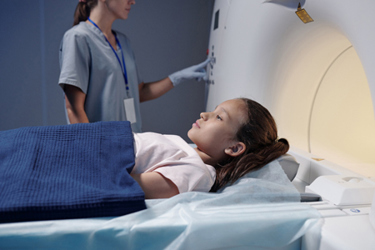Day One Bio's Talks With FDA Help Secure Glioma Drug Approval
A conversation with Elly Barry, MD, chief medical officer, Day One Biopharmaceuticals

Anecdotally, it’s good practice for sponsor companies to “talk with the FDA.” In fact, it’s even a common refrain among the experts sharing advice on Clinical Leader. But does it happen as frequently or as successfully as we are meant to believe? In this case, yes.
Day One Biopharmaceuticals took a passed-over drug from another pharma company’s pipeline and — in lockstep with the FDA — turned it into the first-ever approved treatment for patients with relapsed or refractory pediatric low-grade glioma with BRAF fusions or mutations.
Day One CMO Elly Barry recounts the journey.
Six years from its founding, Day One has secured its first FDA approval with tovorafenib (now OJEMDA™). Tell us about that journey to approval.
Tovorafenib was the first drug we brought into our pipeline. It had been investigated in adults with skin cancers but had been deprioritized in its prior company's pipeline. But it had this proof-of-concept data in pediatric patients with low-grade glioma, which is the most common pediatric brain tumor. And so, Day One soon had an available drug, proof-of-concept data in pediatric cancer, and enough data to design a pivotal registrational trial, a Phase 2 study essentially, in this patient population that had no approved therapies. In fact, the standard of care in relapsed or refractory pediatric low glioma is either chemotherapy or off-label use of experimental agents. (At the time the study was designed, there were no targeted agents approved for pLGG. In 2023,the combination of dabrafenib+trametinib was approved for pLGG, but only for the subset with BRAF mutations [not fusions].)
One of the interesting components was that as we were going back and forth with the FDA, the endpoint of how we describe efficacy in this patient population changed over time. Fortunately for us, we could go back and radiographically reclassify using other classification criteria, but as the pivotal study evolved and our conversations evolved, we were able to get approval based on a pediatric-specific endpoint in this disease, which was the first of its kind and not something that had been done previously.
You mentioned the change in the endpoint over time. How did that evolve?
Because, at the time the study was designed, there had been no other registrational or pivotal studies in pediatric low-grade glioma, , we used a high-grade glioma endpoint to assess efficacy in the study. And that was in agreement with the Agency. That's how medicines for other types of brain tumors had been approved but, again, not in this low-grade setting.
Near the end of the study, the dabrafenib+trametinib combo was approved for pediatric low-grade glioma but using a low-grade endpoint. That prompted the Agency to start thinking about our study a little bit differently. We were able to provide FDA pediatric-specific low-grade criteria, which is something that no one else had done, and it convinced the Agency that was the most relevant endpoint for this disease. This was an evolution of looking at the data in several different ways, and the Agency was learning with us. We provided convincing data that we should be looking at this disease in a very specific way and not in the traditional ways for other types of brain tumors.
How does that communication work between you collecting and analyzing this data and then bringing it to the FDA for discussion?
We were very fortunate that the FDA review division was very collaborative. Even as they were bringing issues to us, they were also looking for solutions, which makes a world of difference. We had several opportunities to hear them and then go back to our corner and think about how we wanted to produce the data and share it with them. It was an evolving dialogue. The other thing that helped us in addition to the standard analysis, tables, and figures were patient narratives. The FDA mentions this in their summary of our approval.
We provided a story for each patient that not only described how they did with their prior treatment before the study but how they fared during the study. We mentioned the objective responses or the actual amount that the tumor decreased in size, but we also described any functional improvements in outcomes. For example, a patient who couldn't previously hold a pencil was now attending school and could write or could run and jump in the playground. In addition to being able to look at the data as a whole, the vignettes for each patient were very helpful to the Agency as they reviewed our application.
It sounds like they were really interested in the human experience with the treatment in addition to the clinical outcomes.
This is a slow-growing tumor in children, and in a sense can be considered a chronic disease. For pediatric low-grade glioma, the typical age for diagnosis is 5 or 6. Even though it's a low-grade glioma, it's a brain tumor often compressing vital structures which can have a lot of functional consequences. By the time patients reach their mid-20s, the tumor stops growing, so, anything you can do to stabilize tumor growth is a benefit. Tumor shrinkage is ideal, but so is the stability of the tumor. For example, if it's pressing on the optic nerve, a little bit more tumor growth might mean that they can't see. The patient's story and how the patient is faring beyond just a percentage change in tumor size is very meaningful from a clinical sense.
A pediatric population is going to have different needs than an adult population. When it comes to trial design, what accommodations did you make?
We look at the testing required in the protocol, and we consider whether that can feasibly be done on a typical clinic day. We think about not only the patient and the caregiver but also the clinic staff. Can all of those feasibly come together to make this happen? We make accommodations accordingly. So, for example, sometimes when we're monitoring the drug levels in the blood during pharmacokinetic testing, we minimize or diminish the number of times we need to sample in a given day. We have to be mindful of the amount of blood we withdraw from small patients because they have smaller overall blood volumes. We also think about providing travel vouchers parking or even childcare support to minimize the burden that clinic visits required for study participation can have on working parents.. .
The other piece, which is always critical in the formulation of the drug, is how easy it is to administer to a pediatric patient. When we initially started this study, we only had a solid dose form, but we developed a liquid formulation that makes it much easier for the smallest patients who can't swallow pills. We were lucky that tovorafenib it is dosed only once a week, and we could give it regardless of whether the patient had eaten or not, which makes that a lot easier for parents and caregivers when you're trying to chase a toddler or a 7-year-old around to get them to take a medication.
Day One’s staff includes a patient advocacy team. How has it made a difference in drug development and the patient experience?
As an example, one of our patient advocacy team members accompanied the clinical team on a site visit. They were talking to the physician leading the study as well as the care team — the nurses, nurse practitioners, and social workers. And she came back with interesting insights after conversations directly with a social worker, about how to best support the patient and the family. She was able to highlight the travel support we offer to the clinic staff, which was not something they were already aware of. It made me realize you can incorporate the advocacy team in a proactive way, even on a site-level visit when talking to the broader caregiving team. In all the years that I was on the academic side and working on industry trials, I never met patient advocacy representative providing support in that way.
Finally, specific to this therapeutic area, do you ever seek advice or input from fellow pharmaceutical companies?
Specific to pediatric oncology, it's a pretty tight community. We have a mission-driven desire to minimize the burden of bringing new medicines to pediatric cancer patients. So, we have several pediatric oncologists on staff at Day One, but we are also very connected with the external pediatric oncology community as a whole, including with pediatric oncologists at other pharmaceutical companies. As we run into challenges or interesting questions or think about other trial designs, we're always having conversations with experts in a particular pathway or a particular disease, because we want to design trials that not only meet regulatory scrutiny but ultimately are clinically meaningful and are able to change the practice in the real world. The pediatric low-grade glioma experience is a bit niche and unique, so there are not a lot of players out there who have this experience, but we rely on each other and learn from past experiences.
About The Expert:
 Elly Barry, MD is a board-certified pediatrician and pediatric hematologist/oncologist with over 15 years of experience in drug development. Prior to joining Day One in 2021, she was global clinical lead for pediatric oncology at Pfizer, as well as head of Pfizer’s pediatric oncology leadership team, where she oversaw more than 10 pediatric oncology clinical programs.
Elly Barry, MD is a board-certified pediatrician and pediatric hematologist/oncologist with over 15 years of experience in drug development. Prior to joining Day One in 2021, she was global clinical lead for pediatric oncology at Pfizer, as well as head of Pfizer’s pediatric oncology leadership team, where she oversaw more than 10 pediatric oncology clinical programs.
She has also held previous roles at Genzyme and Millenium/Takeda focused on the development of oncology therapeutics in adults. Dr. Barry serves on the Industry Advisory Council for CureSearch and is a member of the ACCELERATE Platform Steering Committee. She is also a co-chair of the Children’s Oncology Group Industry Relations Council.
Dr. Barry is a graduate of the pediatric hematology/oncology fellowship program at the Dana Farber Cancer Institute and Children’s Hospital Boston, and the pediatric residency program at Tufts. She received her MD at Yale University School of Medicine and obtained a Masters in Medical Science degree from Harvard Medical School.
